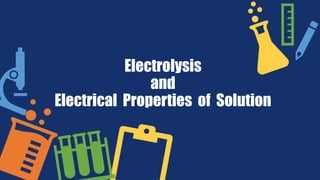
Electrolysis and Electrical Properties of Solution
- 1. Electrolysis and Electrical Properties of Solution
- 2. PRESENTED TO MD. SHAKIL AHMED Lecturer Dept. of Textile Engineering Green University
- 3. The Author’s Shahinur Rahman - 203002070 Joy Pal - 201002418 Fahim Tazwoar Sourav - 201002110 Nusrat Jahan Nizhum - 203002037 Sabina Yasmin Kalpona - 203002023
- 4. Electrolysis Electrical Units FARADAY’s Laws of Electrolysis Conductance of Electrolytes Electrolytic conductance Strong Electrolytes Weak Electrolytes Contents
- 5. Electrolysis • A process where electrical energy is transformed into chemical energy • It is not spontaneous, electrical energy must be supplied for a reaction to occur
- 6. Application of Electrolysis • Electroplating • Extraction of reactive metals such as Na, Al from metal ore • Industrial production of NaOH, Cl2,H2 • Recharging of car batteries & other rechargeable cells • Refining of copper metals
- 8. Electrolytic Conductance of NaCl • An electrolytic cell consists of two electrodes • A DC battery • NaCl (molten)
- 9. Electrical Units Coulomb ( C ) - is a unit quantity of electricity. Ampere ( A ) - is a unit rate of flow of electricity. Ohm ( Ω ) - is a unit of electrical resistance. Volt ( V ) - is a unit of electromotive force.
- 10. FARADAY’s Laws of Electrolysis First Law: The amount of a given product liberated at an electrode during electrolysis is directly proportional to the quantity of electricity which passes through the electrolyte solution. • m = ZQ • Unit is grams per coulomb ( g/C )
- 11. FARADAY’s Laws of Electrolysis Second Law: When the same quantity of electricity passes through solutions of different electrolytes, the amounts of the substances liberated at the electrodes are directly proportional to their chemical equivalents. • 𝑤1 𝑤2 = 𝐸1 𝐸2 • Unit is Volt ( V )
- 12. Conductance of Electrolytes The power of electrolytes to conduct electric currents is termed conductivity or conductance. • The flow of electricity through an electrolytic conductor. • Electricity passes in the form of ions. Three main factors : 1. The concentration of ions 2. The types of ions 3. Temperature
- 13. Specific Conductance • The ability of a substance to conduct electricity. • It is Denoted by K (Kappa). • It is the reciprocal of resistivity ( ρ ). 𝑘 = 𝑙 𝐴 × 1 𝑅 S.I. Unit : S𝒎−𝟏
- 14. Equivalent Conductance • The volume of solution containing one equivalent of an electrolyte. • It is denoted by the symbol Λ ( Lamda). • It is helpful to get comparable results for different electrolytes. 𝛬 = 𝑘 × 1000 𝑁 • Unit : Siemens 𝒎𝟐/equivalent
- 16. Strong Electrolytes • Strong acidic electrolytes : HCl, H2SO4, HNO3 • Strong bases electrolytes : NaOH, KOH, Ca (OH)2 • Salts electrolytes : Most of the salts are electrolytes A substance that gives a solution in which almost all the molecules are ionized.
- 17. Weak Electrolytes A substance that gives a solution in which only a small proportion of the solute molecules are ionized Weak acidic electrolytes : All organic are examples of weak electrolytes. Weak bases electrolytes : Most organic bases e.g., alkyl amines (C2H5NH2) are weak electrolytes Salts : A few salts such as mercury (II) chloride and lead (II) acetate are weak electrolytes
- 18. Non-Electrolytes • Typically polar covalent substances that do dissolve in water as molecules instead of ions. • They do not conduct electricity at all. • Glucose ( C6H12O6 )